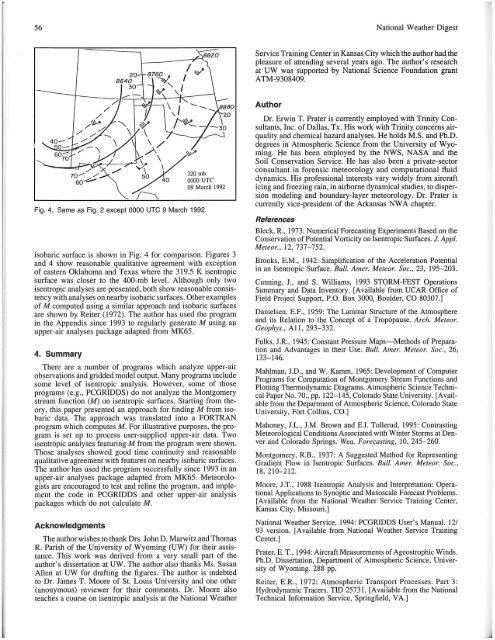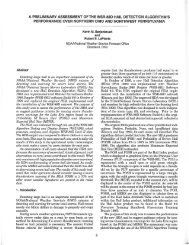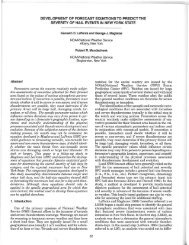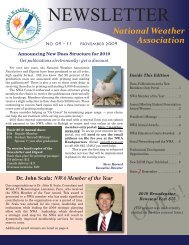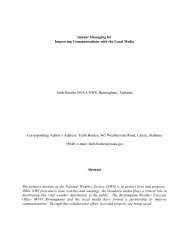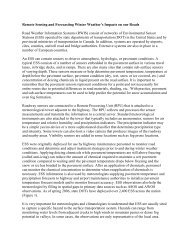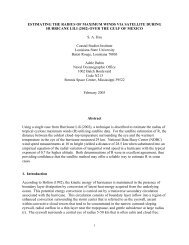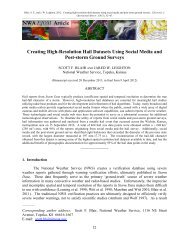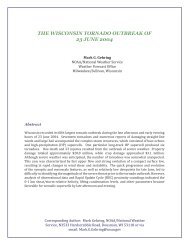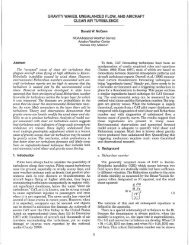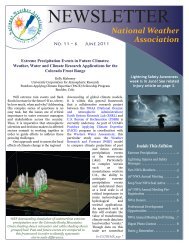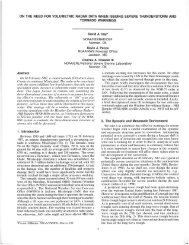A Program for Calculating the Montgomery Stream Function
A Program for Calculating the Montgomery Stream Function
A Program for Calculating the Montgomery Stream Function
You also want an ePaper? Increase the reach of your titles
YUMPU automatically turns print PDFs into web optimized ePapers that Google loves.
56<br />
National Wea<strong>the</strong>r Digest<br />
8820<br />
~ __-:-r-'<br />
Service Training Center in Kansas City which <strong>the</strong> author had <strong>the</strong><br />
pleasure of attending several years ago. The author's research<br />
at UW was supported by National Science Foundation grant<br />
ATM-9308409.<br />
Author<br />
320 mb<br />
0000 UTe<br />
09 March 1992<br />
Fig. 4. Same as Fig. 2 except 0000 UTe 9 March 1992.<br />
isobaric surface is shown in Fig. 4 <strong>for</strong> comparison. Figures 3<br />
and 4 show reasonable qualitative agreement with exception<br />
of eastern Oklahoma and Texas where <strong>the</strong> 319.5 K isentropic<br />
surface was closer to <strong>the</strong> 400-mb level. Although only two<br />
isentropic analyses are presented, both show reasonable consistency<br />
with analyses on nearby isobaric surfaces. O<strong>the</strong>r examples<br />
of M computed using a similar approach and isobaric surfaces<br />
are shown by Reiter (1972). The author has used <strong>the</strong> program<br />
in <strong>the</strong> Appendix since 1993 to regularly generate M using an<br />
upper-air analyses package adapted from MK65.<br />
4. Summary<br />
There are a number of programs which analyze upper-air<br />
observations and gridded model output. Many programs include<br />
some level of isentropic analysis. However, some of those<br />
programs (e.g., PCGRIDDS) do not analyze <strong>the</strong> <strong>Montgomery</strong><br />
stream function (M) on isentropic surfaces. Starting from <strong>the</strong>ory,<br />
this paper presented an approach <strong>for</strong> finding M from isobaric<br />
data. The approach was translated into a FORTRAN<br />
program which computes M. For illustrative purposes, <strong>the</strong> program<br />
is set up to process user-supplied upper-air data. Two<br />
isentropic analyses featuring M from <strong>the</strong> program were shown.<br />
Those analyses showed good time continuity and reasonable<br />
qualitative agreement with features on nearby isobaric surfaces.<br />
The author has used <strong>the</strong> program successfully since 1993 in an<br />
upper-air analyses package adapted from MK65. Meteorologists<br />
are encouraged to test and refine <strong>the</strong> program, and implement<br />
<strong>the</strong> code in PCGRIDDS and o<strong>the</strong>r upper-air analysis<br />
packages which do not calculate M.<br />
Acknowledgments<br />
The author wishes to thank Drs. John D. Marwitz and Thomas<br />
R. Parish of <strong>the</strong> University of Wyoming (UW) <strong>for</strong> <strong>the</strong>ir assistance.<br />
This work was derived from a very small part of <strong>the</strong><br />
author's dissertation at UW. The author also thanks Ms. Susan<br />
Allen at UW <strong>for</strong> drafting <strong>the</strong> figures. The author is indebted<br />
to Dr. James T. Moore of St. Louis University and one o<strong>the</strong>r<br />
(anonymous) reviewer <strong>for</strong> <strong>the</strong>ir comments. Dr. Moore also<br />
teaches a course on isentropic analysis at <strong>the</strong> National Wea<strong>the</strong>r<br />
Dr. Erwin T. Prater is currently employed with Trinity Consultants,<br />
Inc. of Dallas, Tx. His work with Trinity concerns airquality<br />
and chemical hazard analyses. He holds M.S. and Ph.D.<br />
degrees in Atmospheric Science from <strong>the</strong> University of Wyoming.<br />
He has been employed by <strong>the</strong> NWS, NASA and <strong>the</strong><br />
Soil Conservation Service. He has also been a private-sector<br />
consultant in <strong>for</strong>ensic meteorology and computational fluid<br />
dynamics. His professional interests vary widely from aircraft<br />
icing and freezing rain, in airborne dynamical studies, to dispersion<br />
modeling and boundary-layer meteorology. Dr. Prater is<br />
currently vice-president of <strong>the</strong> Arkansas NW A chapter.<br />
References<br />
Bleck, R., 1973: Numerical Forecasting Experiments Based on <strong>the</strong><br />
Conservation of Potential Vorticity on Isentropic Surfaces. 1. Appl.<br />
Meteor., 12,737-752.<br />
Brooks, E.M., 1942: Simplification of <strong>the</strong> Acceleration Potential<br />
in an Isentropic Surface. Bull. Amer. Meteor. Soc., 23, 195-203.<br />
Cunning, J., and S. Williams, 1993 STORM-FEST Operations<br />
Summary and Data Inventory. [Available from UCAR Office of<br />
Field Project Support, P.O. Box 3000, Boulder, CO 80307.]<br />
Danielsen, E.F., 1959: The Laminar Structure of <strong>the</strong> Atmosphere<br />
and its Relation to <strong>the</strong> Concept of a Tropopause. Arch. Meteor.<br />
Geophys., All, 293-332.<br />
Fulks, 1.R., 1945: Constant Pressure Maps-Methods of Preparation<br />
and Advantages in <strong>the</strong>ir Use. Bull. Amer. Meteor. Soc., 26,<br />
133-146.<br />
Mahlman, J.D., and W. Kamm, 1965: Development of Computer<br />
<strong>Program</strong>s <strong>for</strong> Computation of <strong>Montgomery</strong> <strong>Stream</strong> <strong>Function</strong>s and<br />
Plotting Thermodynamic Diagrams. Atmospheric Science Technical<br />
Paper No. 70., pp. 122-145, Colorado State University. [Available<br />
from <strong>the</strong> Department of Atmospheric Science, Colorado State<br />
University, Fort Collins, CO.]<br />
Mahoney, 1.L., J.M. Brown and E.!. Tollerud, 1995: Contrasting<br />
Meteorological Conditions Associated with Winter Storms at Denver<br />
and Colorado Springs. Wea. Forecasting, 10, 245-260.<br />
<strong>Montgomery</strong>, R.B., 1937: A Suggested Method <strong>for</strong> Representing<br />
Gradient Flow in Isentropic Surfaces. Bull. Amer. Meteor. Soc.,<br />
18,210-212.<br />
Moore, J.T., 1988 Isentropic Analysis and Interpretation: Operational<br />
Applications to Synoptic and Mesoscale Forecast Problems.<br />
[Available from <strong>the</strong> National Wea<strong>the</strong>r Service Training Center,<br />
Kansas City, Missouri.]<br />
National Wea<strong>the</strong>r Service, 1994: PCGRIDDS User's Manual. 121<br />
93 version. [Available from National Wea<strong>the</strong>r Service Training<br />
Center.]<br />
Prater, E. T., 1994: Aircraft Measurements of Ageostrophic Winds.<br />
Ph.D. Dissertation, Department of Atmospheric Science, University<br />
of Wyoming. 288 pp.<br />
Reiter, E.R., 1972: Atmospheric Transport Processes. Part 3:<br />
Hydrodynamic Tracers. TID 25731. [Available from <strong>the</strong> National<br />
Technical In<strong>for</strong>mation Service, Springfield, VA.]


